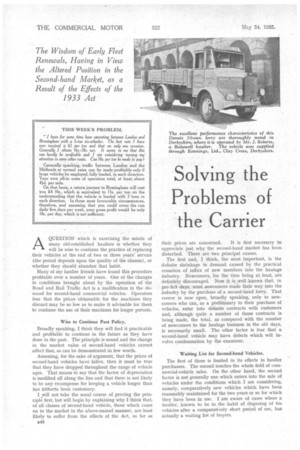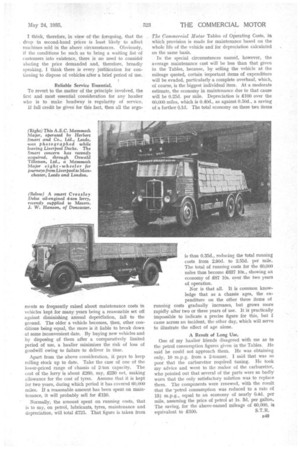• Solving the Problems of the Carrier
Page 66

Page 67

If you've noticed an error in this article please click here to report it so we can fix it.
AQUESTION which is exercising the minds of many old-established hauliers is whether they will be wise to continue the practice of replacing their vehicles at the end of two or three years' service (the period depends upon the quality of the chassis), or whether they should abandon that habit.
Many of my haulier friends have found this procedure profitable over a number of years. One of the changes in conditions brought about by the operation of the Road and Rail Traffic Act is a modification in the demand for second-hand commercial vehicles. Operators fear that the prices obtainable for the machines they discard may be so low as to make it advisable for them to continue the use of their machines for longer periods.
Wise to Continue Past Policy.
Broadly speaking, I think they will find it practicable and profitable to continue in the future as they have done in the past. The principle is sound and the change in the market value of second-hand vehicles cannot affect that, as can be demonstrated in few words.
Assuming, for the sake of argument, that the prices of second-hand vehicles have fallen, then it must be true that they have dropped throughout the range of vehicle ages. That means to say that the factor of depreciation is modified all along the line and that there is not likely to be any recompense for keeping a vehicle longer than has hitherto been customary.
I swill not take the usual course of proving the principle first, but will begin by explaining why I think that, of all classes of second-hand vehicle, those which come on to the market in the above-named manner, are least likely to suffer from the effects of the Act, so far as
B48 their prices are concerned. It is first necessary to appreciate just why the second-hand market has been disturbed. There are two principal causes.
The first and, I think, the most important, is the definite shrinkage in demand caused by the practical cessation of influx of new members into the haulage industry. Newcomers, for the time being at least, are definitely discouraged. Now it is well known that, in pre-Act days, most newcomers made their way into the industry by the purchase of a second-hand lorry. That course is now open, broadly speaking, only to newcomers who can, as a preliininary to their purchase of vehicles, enter into definite contracts with customers and, although quite a number of those contracts is being made, the total, as compared with the number of newcomers to the haulage business in the old days, is necessarily small. The other factor is fear that a second-hand vehicle may have defects which will involve condemnation by the examiner.
Waiting List for Second-hand Vehicles.
The first of these is limited in its effects to haulier purchasers. The second touches the whole field of commercial-vehicle sales. On the other hand, the second factor is not generally one which enters into the sale of vehicles under the conditions which I am considering, namely, comparatively new vehicles which have been reasonably maintained for the two years or so for which they have been in use. I am aware of cases where a haulier, known to be in the habit of disposing of his vehicles after a comparatively short period of use, has actually a waiting list of buyers.
I think, therefore, in view of the foregoing, that the drop in second-hand prices is least likely to .affect machines sold in the above circumstances. Obviously, if the conditions be such as to bring a waiting list of customers into existence, there is no need to considei abating the price demanded and, therefore, broadly speaking, I think there is every justification for continuing to dispose of vehicles after a brief period of use.
Reliable Service Essential.
To revert to the matter of the principle involved, the first and most essential consideration for any haulier who is to make headway is regularity of service.
If full credit be given for this fact, then all the argu merits so frequently raised about maintenance costs in vehicles kept for many years being a reasonable set off against diminishing annual depredation, fall to the ground. The older a vehicle becomes, then, other conditions being equal, the more is it liable to break down at some inconvenient date. By buying new vehicles and by disposing of them alter a comparatively limited period of use, a haulier minimizes the risk of loss of goodwill owing to failure to deliver in time.
Apart from the above consideration, it pays to keep rolling stock up to date. Take the case of one of the lower-priced range of 'chassis of 2-ton capacity. The cost of the lorry is about £260, say, £230 net, making allowance for the cost of tyres. Assume that it is kept for two years, during which period it has covered 60,000 miles. If a reasonable amount has been spent on maintenance, it will probably sell for £130.
Normally, the amount spent on running costs, that is to say, on petrol, lubricants, tyres, maintenance and depreciation, will total £725. That figure is taken from
The Commercial Motor Tables of Operating Costs, in which provision is made for maintenance based on the whole life of the vehicle and for depreciation calculated on the same basis.
In the special circumstances named, however, the average maintenance cost will be less than that given in the Tables, because, by selling the vehicle at the mileage quoted, certain important items of expenditure will be evaded, particularly a complete overhaul, which, of course, is the biggest individual item. At a moderate estimate, the economy in maintenance due to that cause will be 0.25d. per mile. Depreciation is £100 over the 60,000 miles, which is 0.40d., as against 0.50d., a saving of a further 0.1d. The total economy on these two items is thus 0.35d., reducing the total running costs from 2.90d. to 2.55d. per mile. The total of running costs for the 60,000 miles thus become £637 10s., showing an economy of £87 10s. over the two years of operation.
Nor is that all. It is common knowledge that as a chassis ages, the expenditure on the other three items of running costs gradually increases, but grows more rapidly after two or three years of use. It is practically impossible to indicate a precise figure for this, but I came across an incident, the other day, which will serve to illustrate the effect of age alone.
A Result of Long Use.
One of my haulier friends disagreed with me as to the petrol consumption figures given in the Tables. He said he could not approach them. He was obtaining only, 10 m.p.g. from a 2-tonner. I said that was so poor that the carburetter required tuning. He took my advice and went to the maker of the carburetter, who pointed out that several of the parts were so badly worn that the only satisfactory solution was to replace them. The components were renewed, with the result that the -petrol consumption was reduced to a rate of 134 m.p.g., equal to an economy of nearly 0.4d. per mile, assuming the price of petrol at is. 3d. per gallon. The saving, for the above-named mileage of 60,000, is
equivalent to £100. S.T.R.




































































































